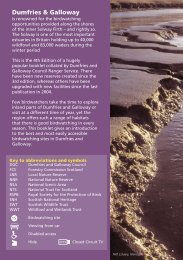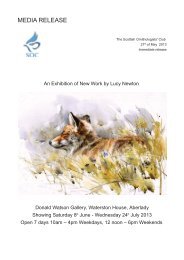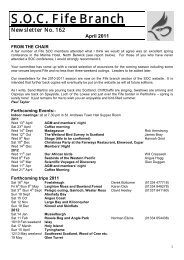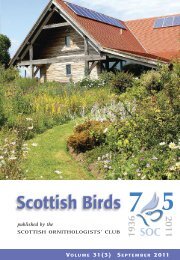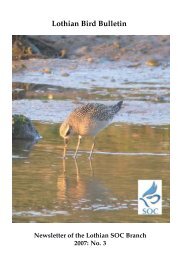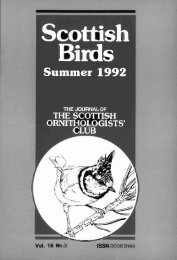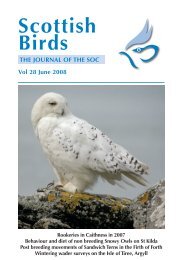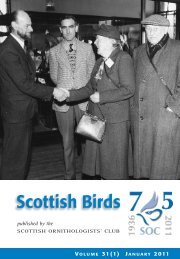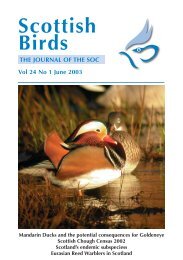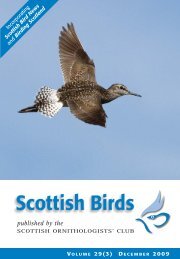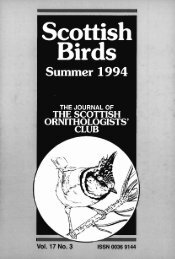V 14 No.4 - The Scottish Ornithologists' Club
V 14 No.4 - The Scottish Ornithologists' Club
V 14 No.4 - The Scottish Ornithologists' Club
You also want an ePaper? Increase the reach of your titles
YUMPU automatically turns print PDFs into web optimized ePapers that Google loves.
256 A. Hogg (Ed.)<br />
S8 <strong>14</strong> (4)<br />
Rarity Descriptions<br />
Bobo6nk on Fair Isle<br />
<strong>The</strong> bird was seen by several observers on<br />
the morning of 29 September 1986, but all<br />
had thought it was just a very bright<br />
Yellow-breasted Bunting! At about 1<br />
p.m. PH phoned to say there was a<br />
Bobolink at Springfield. It was at<br />
Skerryholm when we arrived, but very<br />
flighty. It flew briefly on to a fence, then<br />
up into the sky, high towards Orkney in<br />
the company of Skylarks, before turning<br />
back and heading north over the island<br />
and out of sight. My view of features was<br />
virtually nil, but I was surprised that it<br />
could have been confused with Yellowbreasted<br />
Bunting because its underparts<br />
were a bright (almost orange-) yellow, and<br />
because in bulk it was not far removed<br />
from Skylark with some of that species'<br />
broadness of wing. <strong>The</strong> bird was not<br />
relocated till 1 October. At lunchtime D .<br />
Bird announced that he had brief views of<br />
what was almost certainly the Bobolink in<br />
the oat crop at Bull's Park. After lunch we<br />
all trooped up and saw it, but it frequently<br />
fed in cover. By concentrating on different<br />
features each time it flew, an 'identikit'<br />
picture of plumage details was built up.<br />
<strong>The</strong> following day was windier, and better<br />
views were obtained by NJR as it sat on a<br />
fence, then on some turnips.<br />
Description: Size and shape: hardly smaller than a<br />
Skylark on first view. I would estimate that it was<br />
about the same size and bulk as a male Corn Bunting.<br />
<strong>The</strong> tail looked long and narrow, and appeared very<br />
ragged at the tip (almost as if wet - though both bird<br />
and weather dry when seen). <strong>The</strong> bill looked<br />
disproportionately large and long in comparison with<br />
buntings. Wings seemed rather broad, particularly the<br />
basal part.<br />
Head pattern: very distinctive. Boldly marked<br />
(somewhat similar to, but without the ear-covert<br />
pattern of a Yellow-breasted Bunting). A very broad<br />
brown-black lateral crown stripe ran from base of bill<br />
to hind crown where it seemed to taper slightly at end.<br />
Central crown stripe fairly narrow but well<br />
demarcated, pale yellow. Broad pale yellow<br />
supercilium, running same length as lateral crown<br />
stripe, underlined by thickish dark brown eyestripe<br />
running backwards from eye, straight and ending<br />
relatively square above rear of ear coverts. Earcoverts<br />
pale brown with slight hint of yellowish, fairly<br />
plain but slightly flecked darker. Lores looked dull<br />
grey (no colour discernible) .<br />
Upperparts: nape rather pale brown appearing<br />
virtually unstreaked (some very subtle fine streaking<br />
apparent when on fence) . Mantle by contrast heavily<br />
streaked. General background tone pale yellowishbrown<br />
but with a fairly heavy dark brown streaking.<br />
Mantle dominated by two obvious off-white or<br />
yellowish white braces, running parallel at either side<br />
of mantle from upper mantle towards scapulars -<br />
broadening downwards slightly. No view of backl<br />
rump area but uppertail coverts heavily streaked dark<br />
brown (at least ones on sides). Uppertail dark brown<br />
with buffy fringes to individual feathers (including<br />
uppertail coverts). Tail looked ragged (or spikey) at<br />
tip.<br />
Upperwing: not taken in too well during views.<br />
However, not as heavily streaked 'as mantle, looking<br />
pale brown with some buff fringing. Thin median<br />
covert wing bar off-white (nothing like as marked as in<br />
Yellow-breasted Bunting), no obvious bar on greater<br />
coverts (other than perhaps pencil line). Fairly<br />
indistinct yellowish-buff wing panel (tertial or<br />
secondary edgings) noted.<br />
Underparts: looked really quite bright, rich yellow in<br />
flight. Perched, the overall tone was a pale golden<br />
yellow, richer than brightest Yellow-breasted<br />
Bunting. <strong>The</strong> yellow was strongest on chin, throat and<br />
upper breast. Lower breastlbelly was markedly paler<br />
though still with no buffy tones. <strong>The</strong>re was an area of<br />
buff-brown wash projecting from the sides of the<br />
breast. This was overlaid by some short diffuse midbrown<br />
streaks. Stronger, darker brown streaking was<br />
evident on the flanks, comprising rather randomly<br />
distributed shortish rain drop marks (i.e. not showing<br />
as a series of lines) - fairly sparsely marked, but<br />
denser on lowest flanks immediately below uppertail<br />
coverts.<br />
Bare parts: bill long, wedge shaped, culmen<br />
apparently straight or virtually so. Pale horn, perhaps<br />
slightly darker on upper mandible (not a feature I took<br />
in too well during the views) .<br />
Eye dark. Legs fairly pale straw-brown.<br />
Call: heard a few times, a solitary or twice-uttered<br />
wheezy "plink," not terribly noisy or far-carrying.<br />
This is the second <strong>Scottish</strong> record of<br />
Bobolink Dolichonyx oryzivorus, the first<br />
being on the Out Skerries on 18<br />
September 1975. A record of one on St<br />
Kilda on 28 September 1986 is currently in<br />
circulation with BBRC.<br />
Paul V. Harvey and Nick J. Riddilord



